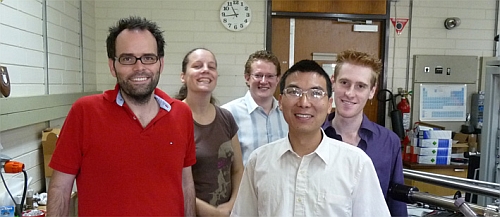Carbon is essential for life as we know it. Its diverse forms – including three-dimensional diamond and graphite, two-dimensional graphene, nanotubes and fullerenes – are also leading to an increasing number of potential industrial applications.
“Materials science is undergoing a carbon renaissance, with carbon’s many forms proving to be an interesting arena for the study of science in the solid state,” says Chris Pakes, who leads the Atom-scale Research Laboratory at La Trobe University.
“Diamond may well be the material of choice in emerging quantum industries, driven by its outstanding properties and recent rapid improvements in the quality of synthetic single-crystal diamond materials. Being made of carbon, it is also bio-compatible.”
The La Trobe team are using the Australian Synchrotron to investigate how to control the electronic properties of the diamond surface by adding one or more layers of carbon in the form of fullerenes. Fullerenes (short for buckminsterfullerenes – named in honour of R. Buckminster Fuller’s geodesic domes) are hollow spheres of 60 carbon atoms arranged in five- and six-membered rings.
The group’s findings are expected to further stimulate the development of diamond-based electronic devices. Key to the current study is that fullerenes on the hydrogen-terminated surface of diamond can act as electron acceptors, introducing a charged layer to the underlying diamond.
“This enables a new approach to molecular-scale electronics,” Chris says. “However, the development of diamond as a material for electronic applications is still in its infancy.”
Martina Wanke, Qi-Hui Wu, Kevin Rietwyk and Chris Pakes visited the Australian Synchrotron recently to study fullerene-diamond interfaces on the soft x-ray spectroscopy beamline, together with La Trobe University colleagues Qihui Wu, Martina Wanke and Kevin Rietwyk and research collaborators Philip Moriarty and Peter Sharp from the University of Nottingham.
The researchers used the soft x-ray beamline to track the accumulation of charge at the diamond surface, indicated by how the diamond's Fermi energy changes as fullerene layers are added, starting from very low fullerene coverage that would not be accessible using laboratory-based x-ray photoelectron spectroscopy. The shift in Fermi energy was lower than expected – an issue that has been seen by several authors and is not well understood.
Chris and his colleagues also used a technique called NEXAFS (near-edge x-ray adsorption fine structure) to probe the fullerene-doped surface. This indicated that the likely cause of the Fermi-level pinning was the presence of a non-diamond defect state in the band-gap of the diamond samples.
The group’s next steps include planning for a series of synchrotron measurements to optimise the hydrogen-terminated surface and to study a range of candidate acceptor molecules with different functional properties.
The synchrotron results are also valuable to the group's overall objective, which is to study and manipulate single-surface fullerenes using low-temperature scanned-probe instrumentation housed in La Trobe University's new Atom-scale Research Laboratory.

Atom-scale Research Laboratory members (L-R): Chris Pakes, Martina Wanke, Mark Edmonds, Qi-Hui Wu and Kevin Rietwyk.
